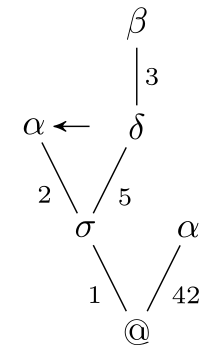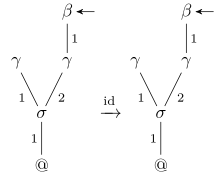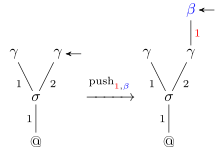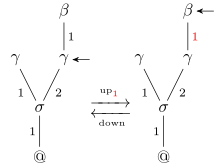Tree stack automaton
A tree stack automaton[lower-alpha 1] (plural: tree stack automata) is a formalism considered in automata theory. It is a finite state automaton with the additional ability to manipulate a tree-shaped stack. It is an automaton with storage[2] whose storage roughly resembles the configurations of a thread automaton. A restricted class of tree stack automata recognises exactly the languages generated by multiple context-free grammars[3] (or linear context-free rewriting systems).
Definition
Tree stack

For a finite and non-empty set Γ, a tree stack over Γ is a tuple (t, p) where
- t is a partial function from strings of positive integers to the set Γ ∪ {@} with prefix-closed[lower-alpha 2] domain (called tree),
- @ (called bottom symbol) is not in Γ and appears exactly at the root of t, and
- p is an element of the domain of t (called stack pointer).
The set of all tree stacks over Γ is denoted by TS(Γ).
The set of predicates on TS(Γ), denoted by Pred(Γ), contains the following unary predicates:
- true which is true for any tree stack over Γ,
- bottom which is true for tree stacks whose stack pointer points to the bottom symbol, and
- equals(γ) which is true for some tree stack (t, p) if t(p) = γ,
for every γ ∈ Γ.
The set of instructions on TS(Γ), denoted by Instr(Γ), contains the following partial functions:
- id: TS(Γ) → TS(Γ) which is the identity function on TS(Γ),
- pushn,γ: TS(Γ) → TS(Γ) which adds for a given tree stack (t,p) a pair (pn ↦ γ) to the tree t and sets the stack pointer to pn (i.e. it pushes γ to the n-th child position) if pn is not yet in the domain of t,
- upn: TS(Γ) → TS(Γ) which replaces the current stack pointer p by pn (i.e. it moves the stack pointer to the n-th child position) if pn is in the domain of t,
- down: TS(Γ) → TS(Γ) which removes the last symbol from the stack pointer (i.e. it moves the stack pointer to the parent position), and
- setγ: TS(Γ) → TS(Γ) which replaces the symbol currently under the stack pointer by γ,
for every positive integer n and every γ ∈ Γ.
 Illustration of the instruction id on a tree stack |
 Illustration of the instruction push on a tree stack |
 Illustration of the instructions up and down on a tree stack |
 Illustration of the instruction set on a tree stack |
Tree stack automata
A tree stack automaton is a 6-tuple A = (Q, Γ, Σ, qi, δ, Qf) where
- Q, Γ, and Σ are finite sets (whose elements are called states, stack symbols, and input symbols, respectively),
- qi ∈ Q (the initial state),
- δ ⊆fin. Q × (Σ ∪ {ε}) × Pred(Γ) × Instr(Γ) × Q (whose elements are called transitions), and
- Qf ⊆ TS(Γ) (whose elements are called final states).
A configuration of A is a tuple (q, c, w) where
- q is a state (the current state),
- c is a tree stack (the current tree stack), and
- w is a word over Σ (the remaining word to be read).
A transition τ = (q1, u, p, f, q2) is applicable to a configuration (q, c, w) if
- q1 = q,
- p is true on c,
- f is defined for c, and
- u is a prefix of w.
The transition relation of A is the binary relation ⊢ on configurations of A that is the union of all the relations ⊢τ for a transition τ = (q1, u, p, f, q2) where, whenever τ is applicable to (q, c, w), we have (q, c, w) ⊢τ (q2, f(c), v) and v is obtained from w by removing the prefix u.
The language of A is the set of all words w for which there is some state q ∈ Qf and some tree stack c such that (qi, ci, w) ⊢* (q, c, ε) where
- ⊢* is the reflexive transitive closure of ⊢ and
- ci = (ti, ε) such that ti assigns for ε the symbol @ and is undefined otherwise.
Related formalisms
Tree stack automata are equivalent to Turing machines.
A tree stack automaton is called k-restricted for some positive natural number k if, during any run of the automaton, any position of the tree stack is accessed at most k times from below.
1-restricted tree stack automata are equivalent to pushdown automata and therefore also to context-free grammars. k-restricted tree stack automata are equivalent to linear context-free rewriting systems and multiple context-free grammars of fan-out at most k (for every positive integer k).[3]
Notes
- not to be confused with a device with the same name introduced in 1990 by Wolfgang Golubski and Wolfram-M. Lippe [1]
- A set of strings is prefix-closed if for every element w in the set, all prefixes of w are also in the set.
References
- Golubski, Wolfgang and Lippe, Wolfram-M. (1990). Tree-stack automata. Proceedings of the 15th Symposium on Mathematical Foundations of Computer Science (MFCS 1990). Lecture Notes in Computer Science, Vol. 452, pages 313–321, doi:10.1007/BFb0029624.
- Scott, Dana (1967). Some Definitional Suggestions for Automata Theory. Journal of Computer and System Sciences, Vol. 1(2), pages 187–212, doi:10.1016/s0022-0000(67)80014-x.
- Denkinger, Tobias (2016). An automata characterisation for multiple context-free languages. Proceedings of the 20th International Conference on Developments in Language Theory (DLT 2016). Lecture Notes in Computer Science, Vol. 9840, pages 138–150, doi:10.1007/978-3-662-53132-7_12.